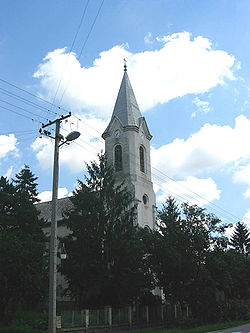
Sajan (village)
Encyclopedia

Kikinda
Kikinda is a town and a municipality located in Serbia, in the autonomous province of Vojvodina. It is the administrative centre of the North Banat District. The town has 42,000 inhabitants, while the municipality has approximately 67,000 inhabitants.The modern city was founded in 18th century...
municipality, in the North Banat District
North Banat District
North Banat District is a northern district of Serbia. It lies in the regions of Banat and Bačka, in the autonomous province of Vojvodina. As of the 2002 census, the district has a population of 165,881. The seat of the district is Kikinda....
of Serbia
Serbia
Serbia , officially the Republic of Serbia , is a landlocked country located at the crossroads of Central and Southeast Europe, covering the southern part of the Carpathian basin and the central part of the Balkans...
. It is situated in the Autonomous Province of Vojvodina
Vojvodina
Vojvodina, officially called Autonomous Province of Vojvodina is an autonomous province of Serbia. Its capital and largest city is Novi Sad...
. The village has a Hungarian
Hungarians in Vojvodina
Hungarians are the second largest ethnic group in the Vojvodina province in northern Serbia. According to the 2002 census, there are 290,207 ethnic Hungarians in Vojvodina who compose 14.28% of the provincial population. The number of ethnic Hungarians in the whole of Serbia is 293,299, and their...
ethnic majority and a population of 1,348 (2002 census).
Name
The village was first mentioned in 1225 under the name of Zeyhan. Zeyhan was the name of a Cuman ruler in the neighbouring county of Bodrogiensis (The nomadic Cumans were settled in the central part of the Pannonian Plain in the medieval Kingdom of HungaryKingdom of Hungary
The Kingdom of Hungary comprised present-day Hungary, Slovakia and Croatia , Transylvania , Carpatho Ruthenia , Vojvodina , Burgenland , and other smaller territories surrounding present-day Hungary's borders...
in the 13th century, and they often controlled also the neighbouring settlements, which were not inhabited by Cumans).
The Cumans are often spoken of as Turan
Turan
Tūrān is the Persian name for Central Asia, literally meaning "the land of the Tur". As described below, the original Turanians are an Iranian tribe of the Avestan age. As a people the "Turanian" are one of the two Iranian peoples both descending from the Persian Fereydun but with different...
people, who migrated from Central Asia
Central Asia
Central Asia is a core region of the Asian continent from the Caspian Sea in the west, China in the east, Afghanistan in the south, and Russia in the north...
and settled in this area. Their primary settlement had been around the Sayan Mountains
Sayan Mountains
The Sayan Mountains are a mountain range between northwestern Mongolia and southern Siberia, Russia.The Eastern Sayan extends from the Yenisei River at 92° E to the southwest end of Lake Baikal at 106° E...
. There are theories that claim this would explain the origin of the name of today's Sajan.
Another theory claim that name Sajan is of Slavic
Slavic languages
The Slavic languages , a group of closely related languages of the Slavic peoples and a subgroup of Indo-European languages, have speakers in most of Eastern Europe, in much of the Balkans, in parts of Central Europe, and in the northern part of Asia.-Branches:Scholars traditionally divide Slavic...
origin, since the Slavic village with similar name Zajan was recorded in Vesprimiensis
Veszprém (former county)
Veszprém was the name of a historic administrative county of the Kingdom of Hungary. Its territory, which was smaller than that of present Veszprém county, in western Hungary. The capital of the county was Veszprém.-Geography:...
county in 1398. It is assumed that name came from the Slavic name Svojan (Jovan M. Pejin, Iz prošlosti Kikinde, Kikinda, 2000).
History
The village belonged to the Csanád County in 1449 and in this time was populated by Slavs.At the beginning of the 19th century, the village of Sajan was in the possession of a landowner named Tajnay János and spread over 9500 acres (38 km²) of land. The first settlers were ethnic Hungarians who came from the area around Szeged
Szeged
' is the third largest city of Hungary, the largest city and regional centre of the Southern Great Plain and the county town of Csongrád county. The University of Szeged is one of the most distinguished universities in Hungary....
in 1805. In order to boost the economic development of the village, Tajnay János invited to the north-east side of the village ethnic Germans
Germans
The Germans are a Germanic ethnic group native to Central Europe. The English term Germans has referred to the German-speaking population of the Holy Roman Empire since the Late Middle Ages....
, and thus appeared the settlement of Wilhelmfeld, which Hungarians called Mihler.
The first school was built in 1828 and its first teacher was Balog András. During the 1848 revolution
Revolutions of 1848 in the Habsburg areas
From March 1848 through July 1849, the Habsburg Austrian Empire was threatened by revolutionary movements. Much of the revolutionary activity was of a nationalist character: the empire, ruled from Vienna, included Austrian Germans, Hungarians, Slovenes, Poles, Czechs, Slovaks, Ruthenians,...
, Sajan was completely burned down and by the end of the century totally abandoned due to a cholera
Cholera
Cholera is an infection of the small intestine that is caused by the bacterium Vibrio cholerae. The main symptoms are profuse watery diarrhea and vomiting. Transmission occurs primarily by drinking or eating water or food that has been contaminated by the diarrhea of an infected person or the feces...
epidemic. After spending a few years in neighbouring Iđoš, the inhabitants returned. A Roman Catholic church was built in 1880.
Historical population
- 1837: 3,362
- 1853: 2,457
- 1900: 2,432
- 1948: 2,430
- 1953: 2,432
- 1961: 2,334
- 1971: 1,982
- 1981: 1,665
- 1991: 1,555
- 2002: 1,348
See also
- List of places in Serbia
- List of cities, towns and villages in Vojvodina

